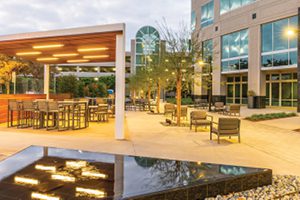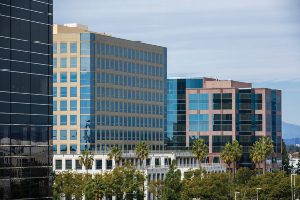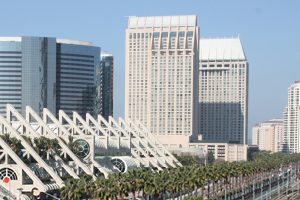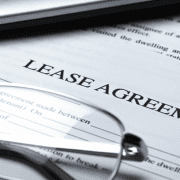SoCal Office Markets Showing Potential Signs of a Rebound
Even with the national U.S. office vacancy rate reaching another all-time high in the second quarter of 2025 (20.7%, according to Moody’s), there are reasons for hope in select Southern California markets.
 In Voit’s recently released Q2 market reports, office specialist Chris Drzyzga, SIOR, SVP/Partner in the Irvine office, reports that “placemaking and experience-driven environments are outperforming traditional stand-alone office buildings,” which is paving the way for “a fundamental shift in how we plan, finance, and operate commercial real estate.” Brandon Keith, SVP/Partner in the San Diego office, points to the rebound in the San Francisco office market as a harbinger for a potential rebound in San Diego, given the proclivity for Southern California commercial real estate to replicate what happens in Bay Area CRE 12–18 months later.
In Voit’s recently released Q2 market reports, office specialist Chris Drzyzga, SIOR, SVP/Partner in the Irvine office, reports that “placemaking and experience-driven environments are outperforming traditional stand-alone office buildings,” which is paving the way for “a fundamental shift in how we plan, finance, and operate commercial real estate.” Brandon Keith, SVP/Partner in the San Diego office, points to the rebound in the San Francisco office market as a harbinger for a potential rebound in San Diego, given the proclivity for Southern California commercial real estate to replicate what happens in Bay Area CRE 12–18 months later.
The Big Picture
Before drilling down into the Southern California markets, let’s look at some national trends.
Return to Work (RTO): According to a recent article by Propmodo, a majority of Fortune 100 companies now require full-time office attendance. Once embraced by 78% of top firms, hybrid models have plummeted to just 41%. Meanwhile, 54% now mandate full in-person work, a significant increase from just 5% two years ago. The shift is reshaping the commercial real estate landscape. Office occupancy climbed 1.3% year over year in April and May, and the demand for high-end office space is surging.
And although Governor Newsom has backtracked on his return-to-office (RTO) mandate for the state’s approximately 95,000 employees — delaying it for one year — several major companies with significant operations in Southern California have mandated RTO policies in 2025, including JPMorgan Chase (a full return to in-office work), Disney (four days a week), Apple (three), and Amazon (three). California state employees will return to the office at least four days per week starting July 1, 2026.
 The effect of the mandates on the overall occupancy levels is unclear. But Kastle Systems, which records utilization levels through security badge swipes, reports that while office attendance patterns vary widely by day and location, average national occupancy across all building types remains around 50%. Tuesdays and Wednesdays are the most popular in-office days, with Class A+ buildings surpassing 90% occupancy. Mondays and Fridays remain low-use days, with attendance significantly below early 2020 levels.
The effect of the mandates on the overall occupancy levels is unclear. But Kastle Systems, which records utilization levels through security badge swipes, reports that while office attendance patterns vary widely by day and location, average national occupancy across all building types remains around 50%. Tuesdays and Wednesdays are the most popular in-office days, with Class A+ buildings surpassing 90% occupancy. Mondays and Fridays remain low-use days, with attendance significantly below early 2020 levels.
Flight to Quality: Although national vacancy rates have reached new highs, well-located and highly amenitized Class A/A+ properties are doing well, achieving record rental rates. Tenants are reducing their footprints and, with the savings, are relocating from Class B and C office buildings to Class A properties, despite the higher rental rates. Class A and A+ office buildings have experienced positive net absorption in most major markets through early 2025, while Class B and C buildings continue to lose tenants.
The flight-to-quality migration represents strategic repositioning by organizations redefining the office’s fundamental purpose. As hybrid work models have evolved, the office has become a strategic tool for collaboration, culture-building, and talent attraction.
CMBS Delinquencies Accelerating: Moody’s reports office-backed CMBS conduit delinquency rate was at an all-time high of 14.26% in June 2025. Although 2024 reported the sharpest annual increase in the office-backed CMBS delinquency rate, concerningly, the first six months of 2025 reflected the fastest midyear increase on record, even surpassing the GFC-related spike in 2010.
Office Owner-Occupiers Gaining Momentum: Companies purchasing their own real estate has always been the domain of industrial users but has become increasingly popular with office users. In a recent article, ULI reported that these types of acquisitions accounted for 20% of total U.S. office sales in the first quarter of 2025, up from 15% for the 12 months of 2024. Before the pandemic, owner-occupier office deals accounted for 8% or less annually. One significant deal in Southern California was Los Angeles County acquiring the 1.3 MSF Gas Company Tower in downtown Los Angeles at 555 W. Fifth Street for $200 million in December 2024.
Office Construction is Shrinking: For the first time in at least 25 years, more office space is being removed through demolition and conversion than added through new construction. According to Commercial Café, there is currently 41.5 MSF of office space under construction.
SoCal Market Snapshots
Orange County
 Orange County’s office vacancy rate rose slightly to 15.79% in Q2 2025, up from 15.48% last quarter but down 55 basis points year over year. The total availability rate decreased to 19.50% from 20.07% last quarter, a positive sign suggesting some space is being leased or withdrawn from the market. The average asking lease rate in Orange County ended Q2 2025 at $2.77 per square foot (PSF), virtually unchanged year over year ($2.76 in Q2 2024). Reflecting national trends, Class A space averaged $3.09 PSF, supported by high-quality, well-located buildings that continue to draw tenants focused on upgraded amenities. Class B and C spaces averaged $2.60 and $1.74 PSF, respectively.
Orange County’s office vacancy rate rose slightly to 15.79% in Q2 2025, up from 15.48% last quarter but down 55 basis points year over year. The total availability rate decreased to 19.50% from 20.07% last quarter, a positive sign suggesting some space is being leased or withdrawn from the market. The average asking lease rate in Orange County ended Q2 2025 at $2.77 per square foot (PSF), virtually unchanged year over year ($2.76 in Q2 2024). Reflecting national trends, Class A space averaged $3.09 PSF, supported by high-quality, well-located buildings that continue to draw tenants focused on upgraded amenities. Class B and C spaces averaged $2.60 and $1.74 PSF, respectively.
Through Q2 2025, no new office space deliveries have been recorded year to date, and only 168,137 SF is nearing completion, mainly The Weave @ OCVIBE project. There is also a clear trend of office properties being repurposed or demolished to meet changing market needs, both of which should reduce the overall vacancy rate.
Forecast: The Orange County office market is expected to move forward at a steady, gradual pace. Vacancy could continue to ease slightly as older, less competitive buildings are removed or repurposed. While large-scale tenant growth remains limited, steady leasing and ongoing rightsizing suggest a more stable foundation ahead. For a more comprehensive look at the OC office market, and to read Chris Drzyzga’s observations on where the market trends are headed, download the Q2 2025 OC Office Market report.
San Diego
 Direct/sublease space (unoccupied) finished Q2 at 14.16%, a significant increase of 1.9 percentage points from the level of a year ago. Much of the spike in vacancy can be attributed to office buildings that were under construction being completed. The San Diego office market is extremely bifurcated. Kearny Mesa is sporting the lowest availability at 11.1%. In comparison, the availability rate in Downtown is 36.5% with more than a third of all Downtown office space vacant. San Diego County’s average asking lease rate hit $3.11 PSF at the end of Q2, a 2% rise from Q2 2024’s rate of $3.05, which is being bolstered by the new office construction completions.
Direct/sublease space (unoccupied) finished Q2 at 14.16%, a significant increase of 1.9 percentage points from the level of a year ago. Much of the spike in vacancy can be attributed to office buildings that were under construction being completed. The San Diego office market is extremely bifurcated. Kearny Mesa is sporting the lowest availability at 11.1%. In comparison, the availability rate in Downtown is 36.5% with more than a third of all Downtown office space vacant. San Diego County’s average asking lease rate hit $3.11 PSF at the end of Q2, a 2% rise from Q2 2024’s rate of $3.05, which is being bolstered by the new office construction completions.
Forecast: Expect continued pressure on rental rates, especially among larger blocks of space, with elevated vacancy levels not expected to improve significantly over the coming months. The market remains heavily influenced by the tenant flight to quality, and landlords with well-located, highly amenitized properties will continue to outperform.
For a more comprehensive look at the San Diego office market, and to read Brandon Keith’s observations on where the market trends are headed, download the Q2 2025 SD Office Market report.
Talk with one of Voit Real Estate Services’ trusted commercial real estate advisors to learn more about how Voit can assist you with building sales and leasing in your market.




 AdobeStock
AdobeStock



